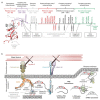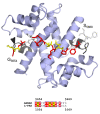Flexible Players within the Sheaths: The Intrinsically Disordered Proteins of Myelin in Health and Disease
- PMID: 32085570
- PMCID: PMC7072810
- DOI: 10.3390/cells9020470
Flexible Players within the Sheaths: The Intrinsically Disordered Proteins of Myelin in Health and Disease
Erratum in
-
Correction: Raasakka, A.; Kursula, P. Flexible Players within the Sheaths: The Intrinsically Disordered Proteins of Myelin in Health and Disease. Cells 2020, 9, 470.Cells. 2022 Feb 14;11(4):662. doi: 10.3390/cells11040662. Cells. 2022. PMID: 35203407 Free PMC article.
Abstract
Myelin ensheathes selected axonal segments within the nervous system, resulting primarily in nerve impulse acceleration, as well as mechanical and trophic support for neurons. In the central and peripheral nervous systems, various proteins that contribute to the formation and stability of myelin are present, which also harbor pathophysiological roles in myelin disease. Many myelin proteins have common attributes, including small size, hydrophobic segments, multifunctionality, longevity, and regions of intrinsic disorder. With recent advances in protein biophysical characterization and bioinformatics, it has become evident that intrinsically disordered proteins (IDPs) are abundant in myelin, and their flexible nature enables multifunctionality. Here, we review known myelin IDPs, their conservation, molecular characteristics and functions, and their disease relevance, along with open questions and speculations. We place emphasis on classifying the molecular details of IDPs in myelin, and we correlate these with their various functions, including susceptibility to post-translational modifications, function in protein-protein and protein-membrane interactions, as well as their role as extended entropic chains. We discuss how myelin pathology can relate to IDPs and which molecular factors are potentially involved.
Keywords: intrinsically disordered protein; multiple sclerosis; myelin; myelination; peripheral neuropathies; protein folding; protein–membrane interaction; protein–protein interaction.
Conflict of interest statement
The authors declare no conflict of interest.
Figures










Similar articles
-
MyelStones: the executive roles of myelin basic protein in myelin assembly and destabilization in multiple sclerosis.Biochem J. 2015 Nov 15;472(1):17-32. doi: 10.1042/BJ20150710. Biochem J. 2015. PMID: 26518750 Review.
-
Functions of short lifetime biological structures at large: the case of intrinsically disordered proteins.Brief Funct Genomics. 2020 Jan 22;19(1):60-68. doi: 10.1093/bfgp/ely023. Brief Funct Genomics. 2020. PMID: 29982297 Review.
-
Advantages of proteins being disordered.Protein Sci. 2014 May;23(5):539-50. doi: 10.1002/pro.2443. Epub 2014 Mar 17. Protein Sci. 2014. PMID: 24532081 Free PMC article. Review.
-
Developmental and pathophysiological aspects of the myelin-associated glycoprotein.Cell Mol Neurobiol. 1988 Jun;8(2):139-48. doi: 10.1007/BF00711240. Cell Mol Neurobiol. 1988. PMID: 2457442 Free PMC article. Review.
-
Introduction to the Thematic Minireview Series on Intrinsically Disordered Proteins.J Biol Chem. 2016 Mar 25;291(13):6679-80. doi: 10.1074/jbc.R116.719930. Epub 2016 Feb 5. J Biol Chem. 2016. PMID: 26851284 Free PMC article.
Cited by
-
Electrical Forces Improve Memory in Old Age.Rev Physiol Biochem Pharmacol. 2025;187:453-520. doi: 10.1007/978-3-031-68827-0_21. Rev Physiol Biochem Pharmacol. 2025. PMID: 39838022 Review.
-
Insights into myelin dysfunction in schizophrenia and bipolar disorder.World J Psychiatry. 2022 Feb 19;12(2):264-285. doi: 10.5498/wjp.v12.i2.264. eCollection 2022 Feb 19. World J Psychiatry. 2022. PMID: 35317338 Free PMC article. Review.
-
Molecular and cellular mechanisms leading to catatonia: an integrative approach from clinical and preclinical evidence.Front Mol Neurosci. 2022 Sep 29;15:993671. doi: 10.3389/fnmol.2022.993671. eCollection 2022. Front Mol Neurosci. 2022. PMID: 36245923 Free PMC article. Review.
-
Intrinsic Disorder and Phase Separation Coordinate Exocytosis, Motility, and Chromatin Remodeling in the Human Acrosomal Proteome.Proteomes. 2025 Apr 28;13(2):16. doi: 10.3390/proteomes13020016. Proteomes. 2025. PMID: 40407495 Free PMC article.
-
How Does Protein Zero Assemble Compact Myelin?Cells. 2020 Aug 4;9(8):1832. doi: 10.3390/cells9081832. Cells. 2020. PMID: 32759708 Free PMC article.
References
-
- Lundgaard I., Luzhynskaya A., Stockley J.H., Wang Z., Evans K.A., Swire M., Volbracht K., Gautier H.O.B., Franklin R.J.M., ffrench-Constant C., et al. Neuregulin and BDNF Induce a Switch to NMDA Receptor-Dependent Myelination by Oligodendrocytes. PLoS. Biol. 2013;11:e1001743. doi: 10.1371/journal.pbio.1001743. - DOI - PMC - PubMed
-
- Young J.Z. The functioning of the giant nerve fibres of the squid. J. Exp. Biol. 1938;15:170–185. - PubMed
Publication types
MeSH terms
Substances
LinkOut - more resources
Full Text Sources
Medical

